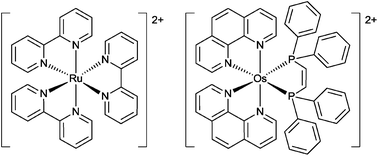Paul S. Francis from Deakin University, Australia, and colleagues from Australia and the USA have studied osmium complexes that contain phenanthroline, diphosphine and diarsine ligands and assessed their potential as chemiluminescence reagents. Osmium complexes do have some advantages over their ruthenium counterparts. The larger crystal field strength of the heavy metal raises the energy of the non-emissive d–d states. This in turn reduces thermal deactivation of the metal-to-ligand charge transfer (MLCT) states, creating greater photostability.
Click here to read more about these interesting complexes.
Chemiluminescence from osmium(II) complexes with phenanthroline, diphosphine and diarsine ligands
Elizabeth M. Zammit, Gregory J. Barbante, Brenden Carlson, Egan H. Doeven, Neil W. Barnett, Conor F. Hogan, Mark M. Richter and Paul S. Francis
Analyst, 2012, Advance Article
DOI: 10.1039/C2AN35446B











